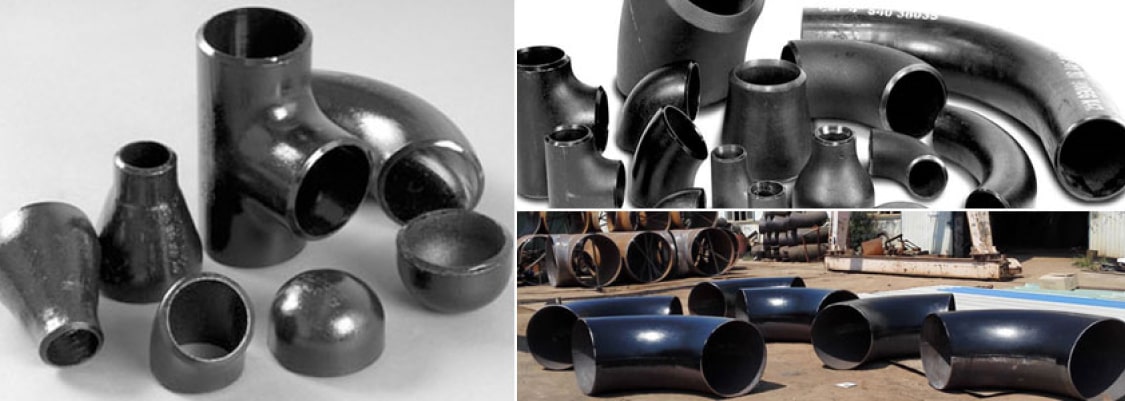Pipe Fittings

Types of Pipe Fittings
- Elbows
- Used to change the direction of the flow, typically at angles of 45°, 90°, or 180°.
- Available in long radius (LR) and short radius (SR) designs.
- Tees
- Allow for branch connections at a 90° angle from the main pipe.
- Types include equal tees (same diameter across all outlets) and reducing tees (different diameters for the branch outlet).
- Crosses
- Have four connection points at right angles, allowing for complex piping layouts.
- Common in fire suppression and sprinkler systems.
- Reducers
- Change the pipe diameter, transitioning from a larger pipe to a smaller one.
- Available as concentric reducers (aligned centerline) or eccentric reducers (offset centerline).
- Caps and Plugs
- Seal off the end of a pipe, often used for maintenance or inspection.
- Caps fit over the outside of a pipe, while plugs fit into the pipe.
- Stub Ends
- Typically used with lap joint flanges for easy disassembly of the piping system.
- Commonly found in applications where frequent inspection or cleaning is required.
- Couplings and Unions
- Join two pipes, with couplings typically used for permanent connections and unions for connections that may need to be disassembled.
- Nipples
- Short lengths of pipe with threading on both ends, used to connect two fittings or pipes.
- Available in various configurations such as hexagon, plain, or swaged.
Materials Used in Pipe Fittings
- Stainless Steel: Resistant to corrosion, suitable for high-temperature and high-pressure applications. Commonly used in industries like food processing, chemical, and pharmaceutical.
- Carbon Steel: Strong and durable, often used in industrial piping systems, but prone to rust if not coated.
- Copper: Excellent for plumbing and HVAC systems due to its natural resistance to corrosion and antimicrobial properties.
- PVC and CPVC: Lightweight and resistant to chemicals, ideal for plumbing and drainage systems.
- Alloy Steel: Used in high-temperature applications and industries requiring corrosion resistance, such as petrochemical plants.
Pipe Fitting Standards and Specifications
Pipe fittings are manufactured to meet specific standards for quality, safety, and performance. Common standards include:
- ASME B16.9: Factory-made wrought buttwelding fittings.
- ASME B16.11: Forged fittings, socket welding, and threaded.
- ASTM A234: Standard for wrought carbon and alloy steel fittings for moderate and high-temperature services.
- ASTM A403: Specification for wrought austenitic stainless steel fittings.
- DIN and EN Standards: European standards that define pipe fittings and flanges for various applications.
Common Applications of Pipe Fittings
- Oil and Gas Industry: High-strength fittings for pipelines transporting oil, gas, and other hydrocarbons.
- Chemical Processing: Corrosion-resistant fittings for handling aggressive chemicals.
- Water Treatment: Fittings for piping systems that manage potable water, wastewater, and desalination.
- HVAC Systems: Pipe fittings for heating, ventilation, and air conditioning, often requiring corrosion-resistant materials.
- Food and Beverage: Sanitary fittings for clean and contamination-free flow, typically made from stainless steel.
Marking & Packing
To ensure that our products reach you in perfect condition, we employ careful packaging methods. For export, we use standard wooden cases for maximum protection during transit. Each fitting is marked with:
- Grade
- Lot Number
- Size
- Degree
- Our Trademark
Custom marking requests can also be accommodated upon special request.
Quality Assurance
At Riyaarth Overseas, quality is our top priority. All our fittings and flanges undergo stringent inspections at each stage of production, from the procurement of raw materials to final dispatch. We conduct visual examinations to ensure conformity with ASTM, ASME, MSS, DIN, EN, and JIS codes and standards.
We are committed to transparency and reliability, offering:
- Manufacturer Test Certificate as per EN 10204 / 3.1B
- Raw Materials Certificate
- 100% Radiography Test Report
- Third-Party Inspection Report
Riyaarth Overseas is your trusted partner for high-quality alloy steel pipe fittings and flanges. With our commitment to quality, custom manufacturing capabilities, and extensive industry experience, we are well-equipped to meet your specific requirements. Contact us today to learn more about our products and services or to request a quote!
FAQs
Threaded fittings are screwed onto the pipe and are often used for low-pressure, small-diameter applications. Socket weld fittings involve welding the pipe into the fitting, creating a stronger and leak-proof connection for high-pressure systems.
Consider factors like the type of fluid or gas, temperature, pressure, and environmental conditions. For example, stainless steel is ideal for corrosive environments, while PVC is more suitable for low-temperature water systems.
Stainless steel fittings offer high corrosion resistance, durability, and strength, making them ideal for harsh environments and industries requiring hygienic and contamination-free conditions.

Products
Industry We Serve
- Oil & Gas industries
- Chemical process industries
- Pump and valve in high pressure component
- Food industries
- Pulp and paper industry
- Aerospace industry
- Power plant
- Mechanical component
- Sugar industry
- Cement industry
